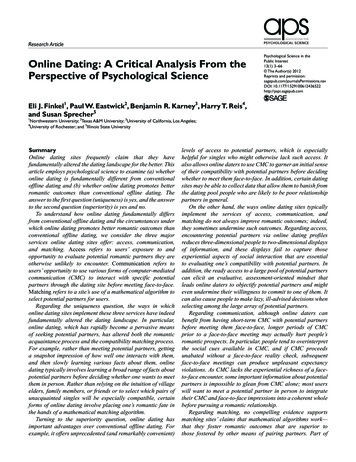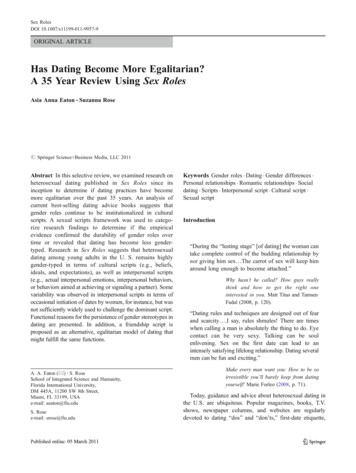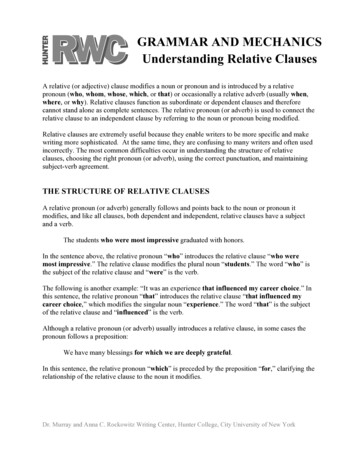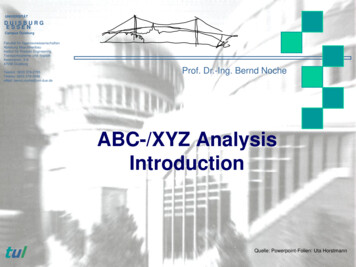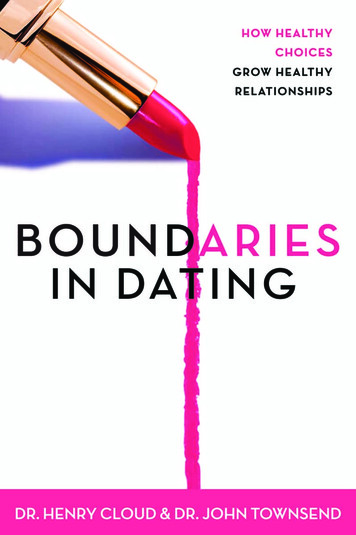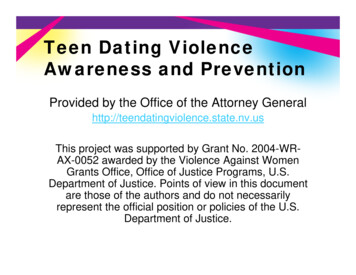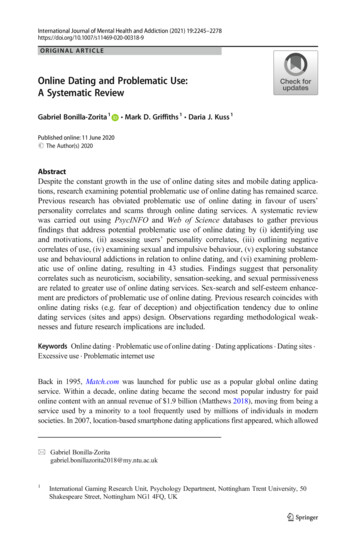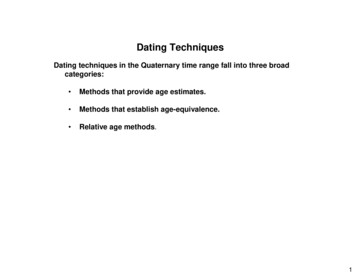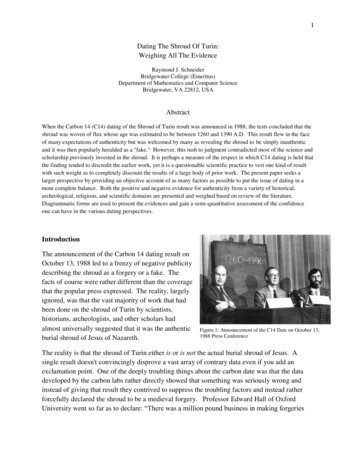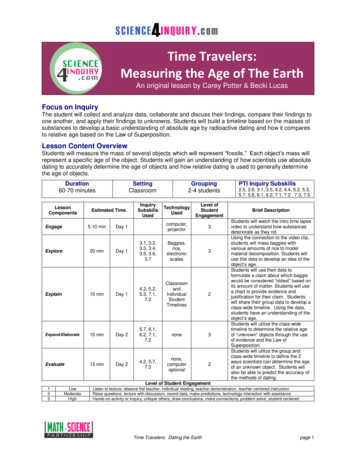
Transcription
Time Travelers:Measuring the Age of The EarthAn original lesson by Carey Potter & Becki LucasFocus on InquiryThe student will collect and analyze data, collaborate and discuss their findings, compare their findings toone another, and apply their findings to unknowns. Students will build a timeline based on the masses ofsubstances to develop a basic understanding of absolute age by radioactive dating and how it comparesto relative age based on the Law of Superposition.Lesson Content OverviewStudents will measure the mass of several objects which will represent “fossils.” Each object’s mass willrepresent a specific age of the object. Students will gain an understanding of how scientists use absolutedating to accurately determine the age of objects and how relative dating is used to generally determinethe age of objects.Duration60-70 minutesLessonComponentsSettingClassroomEstimated TimeInquirySubskillsUsedGrouping2-4 studentsTechnologyUsedLevel ofStudentEngagementcomputer,projector3Engage5-10 minDay 1Explore20 minDay 13.1, 3.2,3.3, 3.4,3.5, ndividualStudentTimelines2Explain10 minDay 14.2, 5.2,5.3, 7.1,7.2Expand/Elaborate10 minDay 25.7, 6.1,6.2, 7.1,7.2none3Evaluate15 minDay 24.2, 5.7,7.3none,computeroptional2PTI Inquiry Subskills2.5, 2.6, 3.1, 3.5, 4.2, 4.4, 5.2, 5.3,5.7, 5.8, 6.1, 6.2, 7.1, 7.2 , 7.3, 7.5Brief DescriptionStudents will watch the intro time lapsevideo to understand how substancesdeteriorate as they rot.Using the connection to the video clip,students will mass baggies withvarious amounts of rice to modelmaterial decomposition. Students willuse this data to develop an idea of theobject’s age.Students will use their data toformulate a claim about which baggiewould be considered “oldest” based onits amount of matter. Students will usea chart to provide evidence andjustification for their claim. Studentswill share their group data to develop aclass-wide timeline. Using the data,students have an understanding of theobject’s age.Students will utilize the class-widetimeline to determine the relative ageof “unknown” objects through the useof evidence and the Law ofSuperposition.Students will utilize the group andclass-wide timeline to define the 2ways scientists can determine the ageof an unknown object. Students willalso be able to predict the accuracy ofthe methods of dating.Level of Student Engagement123LowModerateHighListen to lecture, observe the teacher, individual reading, teacher demonstration, teacher-centered instructionRaise questions, lecture with discussion, record data, make predictions, technology interaction with assistanceHands-on activity or inquiry; critique others, draw conclusions, make connections, problem-solve, student-centeredTime Travelers: Dating the Earthpage 1
Next Generation Science Standards – InquiryNGSS Practice 3: Planning and Carrying Out InvestigationsNGSS Practice 4: Analyzing and Interpreting DataNGSS Practice 6: Constructing explanationsNGSS Practice 7: Engaging in arguments from evidenceNGSS Practice 4: Analyzing and Interpreting DataNext Generation Science Standards – Earth ScienceMS-ESS1-4: Construct a scientific explanation based on evidence from rock strata for howthe geologic time scale is used to organize Earth’s 4.6-billion-year-old history.ESS1.C: The History of Planet EarthThe geologic time scale interpreted from rock strata provides a way to organize Earth’s history.Analyses of rock strata and the fossil record provide only relative dates, not an absolute scale.Florida Science Standards – Nature of ScienceSC.912.N.1.1: Define a problem based on a specific body of knowledge, for example: biology,chemistry, physics, and earth/space science, and conduct systematic observations, examinetext and other sources of information to see what is already known, use tools to gather, analyze, andinterpret data, pose explanations or descriptions of events, use appropriate evidence and reasoning tojustify these explanations to others, communicate results of scientific investigations, and evaluate themerits of the explanations produced by others.Florida Science Standards – Earth ScienceSC.7.E.6.3: Identify current methods for measuring the age of Earth and its parts, including theLaw of Superposition and radioactive dating.Materials and Advance PreparationMaterials ListClass set: Classroom Timeline A on poster paper or chart paper LAMINATED – 1 for each group (BlacklineMaster 1) Classroom Timeline B on poster paper with preprinted fossils LAMINATED – 1 for each group(Blackline Master 1) Class set of Mass to Date Correspondence Chart (Blackline Master 4) Object Cards and Unknown Fossil copies for each group (Blackline Master 2 & 5)Student materials: Pen or pencil Student Blackline Master Handout (Blackline Master 3) Rice 4 Ziploc bags for each lab group Digital scaleBlackline Masters1. Blackline Master 1: Classroom Timelines (A and B)2. Blackline Master 2: Object Cards3. Blackline Master 3: Time Travelers Student Handout4. Blackline Master 4: Mass to Date Correspondence Chart5. Blackline Master 5: Unknown Fossils6. Blackline Master 6: Teacher Set-Up Directions7. Blackline Master 7: Time Travelers Formative Assessment - Exit Ticket8. Blackline Master 8: Time Travelers Summative Assessment9. Blackline Master 9: Answer KeysTime Travelers: Dating the Earthpage 2
Advance Preparation1. Prepare the video for the engage activity: https://youtu.be/2jeYXGJyY9kNOTE: If there is an advertisement at the beginning of the video, please fast forward or “Skip”through the ad if available. Make sure to display the video full screen (arrows to the right of videotime bar at the bottom of the screen) so that the web page advertisements and other suggestedvideos are not seen. Watch for and close any pop-up ads that may occur during the video.2. Make copies of the Time Travelers Student Handout Blackline Master 3 (1 per student/groupdepending on teacher’s preference)3. Make copies of The Object Cards Blackline Master 2 (1 per group) and cut them into 4 separatecards.4. Make copies of The Mass to Date Correspondence Chart Blackline Master 4 (1 per group)5. Make copies of the Unknown Fossils Blackline Master 5 and cut the fossils apart. Each group willneed one fossil.6. Make copies of the Time Travelers Formative Assessment Blackline Master 7 if appropriate.7. Make copies of the Time Travelers Summative Assessment Blackline Master 8 if appropriate.8. Set up all lab stations (see specific directions – Blackline Master 6).9. Build the Timelines A and B on poster paper or chart paper – Blackline Master 1.Lesson InformationLearning Objectives1. Students will be able to collect data, analyze data, collaborate and discuss their findings, comparetheir findings to one another, and apply their findings to unknowns.2. Students will be able to identify current methods for measuring the age of Earth and its parts, includingthe law of superposition and radioactive dating.Prior Knowledge Needed by the Students Students need to be able to use a digital scale to accurately measure mass. Students need tohave basic experimentation skills.Background InformationGeologists use two basic types of dating: absolute dating and relative dating. Dating the age ofrocks is critical to understanding and reconstructing Earth's history. Absolute dating (may be referred toas radioactive or carbon) establishes how many years ago a given event took place. The most importantmethods of absolute dating are based on the decay of naturally occurring radioactive elements. Relativedating places historical events in their correct order but does not give numerical estimates of how manyyears ago the events happened. One might think that if scientists can determine the numerical ages ofrocks and fossils they should be able to put evidence of ancient life in the correct historical order. Theproblem is that only some types of rocks and fossils can be absolutely dated, so all other evidence ofancient life must be related to age-dated material by the techniques of relative dating through the law ofsuperposition.Absolute DatingAbsolute dating provides science with a powerful tool for reconstructing our planet’s history. The idea thatradioactivity could be used as a measure of the age of geologic formations was first suggested by aBritish physicist, Lord Rutherford in 1905. In 1907 Professor B. B. Boltwood, a radiochemist at YaleUniversity, made the first attempt to establish a geologic time scale. The invention of the massspectrometer after World War I led to the discovery of isotopes (see below) and the calculation ofaccurate decay rates. Precise dating was not achieved and accepted by the scientific community until the1950s. The methodologies and instruments for radiometric dating have been expanded and fine-tuned insince, and very accurate dating is now possible.Atoms of the same element with different atomic masses are called isotopes.Carbon-14 dating is probably one of the best-known dating methods, but the half-life of Carbon-14 isapproximately 5730 years. That makes the half-life far too short for dating material that is millions of yearsold. Other isotopes, however, do decay extremely slowly and can be used as geologic clocks.Time Travelers: Dating the Earthpage 3
These isotopes are:PARENT ISOTOPEHALF-LIFESTABLE DAUGHTERUranium-235704 Million YearsLead-207Potassium-401.25 Billion YearsArgon-40Uranium-2384.5 Billion YearsLead-206Thorium-23214.0 Billion YearsLead-208Lutetium-17635.9 Billion YearsHafnium-176Rubidium-8748.8 Billion YearsStrontium-87Samarium-147106 Billion YearsNeodymium-143Depending on the kind of rock studied, data can give different kinds of information. Igneous rock isformed from cooling magma or lava, and it contains small amounts of radioactive elements. As igneousrock erodes, the eroded particles are deposited to become sedimentary rock. Dating sedimentary rock byusing radioactive techniques will tell the age of the original igneous rock, not the time since thesedimentary rock formed. Metamorphic rock, by contrast, is formed from earlier rock through intense heatand pressure. Metamorphism can reset some radiometric clocks, so that radioactivity record the time ofalteration rather than the date when the earlier rock first solidified from magma or was deposited assediment.The oldest dated rocks on Earth come from northern Canada and are about 4 billion years old. Manyrocks older than 3 billion years have been found on the Earth. Moon rocks have been dated at 4.4 to 4.5billion years. Meteorites that are left over from the earliest time of the solar system have been dated at4.4 to 4.6 billion years.Retrieved from http://paleobiology.si.edu/geotime/main/foundation dating1.htmlTeachers should note that many students may not have had basic chemistry to this point. Some may nothave been taught anything about elements. For this reason, radioactive decay will only be taughtconceptually as decay or rot. The discussion of half-lives and radioactivity goes beyond the scope of thisFlorida standard.Lesson ProcedureEngage2. Students will watch a video clip showing the time lapse of a rotting apple:https://youtu.be/2jeYXGJyY9kNOTE: If there is an advertisement at the beginning of the video, please fast forward or “Skip”through the ad if available. Make sure to display the video full screen (arrows to the right of videotime bar at the bottom of the screen) so that the web page advertisements and other suggestedvideos are not seen. Watch for and close any pop-up ads that may occur during the video.3. Some questions you can ask the students following the video include:a. What did you observe about the mass of the apple after one month? There wasn’t muchnoticeable change to the apple after 1 month.b. Was there any apple left after 4 months? It appeared as though there was approximately½ of the apple left after 4 months.c. Where does the mass of the apple go as it decays or rots? Students may have troubleanswering this question. Student responses may vary but could include that it goes into theair, the mass just shrinks and gets smaller, or the mass disappears. The correct response isthat the rotting process releases the matter as gas.3. At this point in the lesson the teacher makes the connection between decay/rot and radioactivedecay by saying “Scientists use a method called radioactive decay to determine the amount ofTime Travelers: Dating the Earthpage 4
radioactive elements that are found within fossils and rocks. The amount of decay determinesthe age of these fossils and rocks. Today, you will be using bags of rice to model the amount ofdecay that has occurred to objects within the Earth.”Explore1. In lab groups, students will be given 4 baggies of rice. Each baggie represents a rock/fossil foundwithin the Earth. Each baggie should be filled with rice premeasured by the teacher (directionscan be found on the Object Cards - Blackline Master 2.2. Students will collaborate to determine which “fossil/rock” (represented by the baggies in their labgroup) would be considered “4-oldest” to “1-youngest.”a. Students should draw on their understanding of age related to mass from the rottingapple video.b. Students will measure the masses of the 4 baggies of rice.c. Students will write the mass on the data table of their Time Travelers Student Handoutand on the corresponding Object Card.d. Students will rank the age of their baggies on the data table of their Time TravelersStudent Handout and place the Number in the circle on the Object Cards.3. Some questions the teacher might ask students while they work include:a. If the baggies represent objects found within the earth, which objects would beolder, which objects would be younger? The older objects would be the one with lessmass; the younger have more mass.b. How do you know? As time goes on, the rocks/fossils lose mass (like the apple rotting),so the oldest rocks/fossils have the least mass.c. Make a comparison statement between your baggies (i.e. “Baggie 2 is older thanbaggie 4 and baggie 3 is younger than baggie 1.”) Baggie D is the youngest, then B,A, and C is the oldest.d. How certain are you of the objects age? Student responses will varye. Could you give an actual number age? Student responses will varyf. What additional information would you need to determine the actual age of thefossil? Student responses will vary4. At this time, the teacher will give the lab groups the Mass to Date Correspondence Chart –Blackline Master 4.a. Students will determine the ages of the items using Mass to Date Correspondence Chartand write the data in the data table on their Student Handout.b. Students will also transfer this data to the Object Card attached to each baggie.5. While students are working in their lab groups, the teacher moves from group to group to ensurethat students are using proper measurement and lab procedures and answering questions asneeded.6. It is recommended that several Object Cards are premade to attach to the outside of the baggiesfor each class period. The set of baggies, but not the Object Cards, can be used multiple times.7. Please see the Teacher Lab Prep Directions for additional information on how to prepare for thelabs – Blackline Master 6.Explain1. To demonstrate their understanding of their experiences, students will analyze the data that theyhave collected and compare their data to the data of other groups. Each group will place theirObject Cards on the Class Timeline A (Blackline Master 1) according to where it falls in theclassroom data.2. Some questions the teacher might ask students while they work include:a. If the baggies represents a fossil or rock found within the earth, which would befound closer to the surface of the Earth (top of Timeline A) and which would becloser to the center of the Earth (bottom of Timeline A)? The baggies with moremass would be found near the top and the baggies with less mass would be found towardthe bottom.b. How do you know? The longer a fossil/rock has been “rotting,” the more mass it loses(like in the apple rotting video).Time Travelers: Dating the Earthpage 5
3. Students will attach their Object Cards (with the mass and corresponding age written on it) to theClass Timeline A - Blackline Master 1.4. After all of the Object Cards have been attached to the Classroom Timeline A, students will beasked to explain Classroom Timeline A on their Time Travelers Student Handout.a. What do you notice about the correlation between the age of the object and themass of the object? The baggies with more mass are younger. The baggies with lessmass are older.b. How certain are you that the age of your objects are correct? Student responses willvary but the students should be fairly certain since they have the mass to agecorrespondence chart.c. What evidence makes you certain? Student responses will vary but should includedata from the mass to age correspondence chart.5. Using their data table and experience, students will write a “definition” of relative age and absoluteage on their Time Travelers Student Handout (Question 1 and 2).Expand1. Teacher will reveal Classroom Timeline B.2. Groups will be given an “unknown fossil” – Blackline Master 5. Teacher will say “Sometimesscientists cannot determine the amount of radioactive decay in some objects. They must rely onother ways to determine the age of the object.”3. Students will use the Classroom Timeline B to make a claim as to where their unknown fossil fits.4. Students will be asked to make a prediction of the fossil’s age, whether it is a relative age orabsolute age, and give evidence that supports their answers (Questions 3 – 5) on their TimeTravelers Student Handout.5. Students will be asked to develop a “rule” that explains the relative date associated with theirunknown fossilEvaluateFORMAL EVALUTION1. Time Travelers Summative Assessment – Blackline Master 8INFORMAL or OPTIONAL EVALUTIONS1. Student questioning (see Explain Section)2. Student/group handout3. Data Tables and/or Lab Findings4. Time Travelers Formative Assessment Exit Ticket options – Blackline Master 7Supplementary ResourcesTeachersAgroscope. (2013). Rotting apple video clip. Retrieved from https://youtu.be/2jeYXGJyY9kBuckley, D. (2012) Interactive Science, Course 2, Pearson Prentice Hall, tion dating1.htmlSmithsonian National Museum of Natural History. (2016). Fossil Lab. Retrieved fromhttp://paleobiology.si.edu/fossiLab/National Museum of Natural History. (n.d.) Foundational Concepts: Intro to Dating. Retrieved tion dating1.htmlStudentsBuckley, D. (2012) Interactive Science, Course 2, Pearson Prentice Hall, Inc.Geiger, B. (2014). Kids Discover: Geologic Age Dating Explained. Retrieved eologic-age-dating-explained/Time Travelers: Dating the Earthpage 6
Smithsonian National Museum of Natural History. (2016). Fossil Lab. Retrieved fromhttp://paleobiology.si.edu/fossiLab/University of Colorado Boulder. (2016). pHet: Radioactive Dating Game. Retrieved ctive-dating-gameCITATION OF SOURCESBuckley, D. (2012) Interactive Science, Course 2, Pearson Prentice Hall, Inc.Creative Commons. (1896). Scallop shell. Retrieved fromhttps://commons.wikimedia.org/wiki/File:PSM V49 D563 Scallop shell.jpgNational Museum of Natural History. (n.d.) Foundational Concepts: Intro to Dating. Retrieved tion dating1.htmlOpenClipartVectors. (2013) Prehistoric Fish Clipart. Retrieved from ic-153046/OpenClipartVectors. (2016).Seashell Picture. Retrieved from hell-1297386/St. John, J. (2011). Priscacara serrata fossil fish. Retrieved 553678United States Geological Survey. (1997). Index Fossil Pictures. Retrieved fromhttps://commons.wikimedia.org/wiki/File:Index fossils.gif Yes, I cited all materials and resources used in this lesson.Becki Lucas and Carey PotterLesson author’s signaturesTime Travelers: Dating the Earthpage 7
Blackline Master 1Class Timeline ATime Travelers: Dating the Earthpage 8
Blackline Master 1Class Timeline BTime Travelers: Dating the Earthpage 9
Blackline Master 2Object CardsTime Travelers: Dating the Earthpage 10
Blackline Master 3Time Travelers Student HandoutRelative Age(1 Youngest – 4 Oldest)Mass (grams)Absolute Age(in Millions of Years)Baggie ABaggie BBaggie CBaggie D1. What is the difference between the Relative Age of an object and the Absolute Age of an object?2. How can you determine this difference?3. Predict the age of your “unknown” fossil?4. Is your prediction a Relative Age or an Absolute Age?5. What evidence did you use to determine the age of your “unknown” object?6. Write a relative age statement about your “unknown” fossil. (Ex: My fossil is older than andyounger than .Time Travelers: Dating the Earthpage 11
Blackline Master 4Mass to Age Correlation ChartMassAge240 g – 230 gPresent Day – 10 Million Years Ago229 g – 220 g11 Million Years Ago – 20 Million Years Ago219 g – 210 g21 Million Years Ago – 30 Million Years Ago209 g – 200 g31 Million Years Ago – 44 Million Years Ago199 g – 190 g45 Million Years Ago – 54 Million Years Ago189 g – 180 g55 Million Years Ago – 64 Million Years Ago179 g – 170 g65 Million Years Ago – 100 Million Years Ago169 g – 160 g101 Million Years Ago – 139 Million Years Ago159 g – 150 g140 Million Years Ago – 169 Million Years Ago149 g – 140 g170 Million Years Ago – 200 Million Years Ago139 g – 130 g201 Million Years Ago - 225 Million Years Ago129 g – 120 g226 Million Years Ago - 249 Million Years Ago119 g – 110 g250 Million Years Ago – 300 Million Years Ago109 g – 100 g301 Million Years Ago – 350 Million Years Ago99 g – 90 g351 Million Years Ago – 400 Million Years Ago89 g – 80 g401 Million Years Ago – 480 Million Years Ago79 g – 70 g481 Million Years Ago - 500 Million Years Ago69 g – 60 g501 Million Years Ago - 549 Million Years Ago59 g – 50 g550 Million Years Ago – 575 Million Years Ago49 g – 40 g576 Million Years Ago – 590 Million Years Ago39 g – 30 g591 Million Years Ago – 610 Million Years Ago29 g- 20 g611 Million Years Ago – 630 Million Years Ago19 g – 10 g631 Million Years Ago - 650 Million Years Ago9g–0gOver 650 Million Years AgoTime Travelers: Dating the Earthpage 12
Blackline Master 5Unknown FossilsTime Travelers: Dating the Earthpage 13
Blackline Master 6Teacher Lab Prep DirectionsRice Baggies1. You will need 4 ziploc baggies for each group.2. Using permanent marker, write letters A, B, C, and D on one of each of the 4baggies.3. Fill the baggies with the following amounts of rice: Baggie A: Rice in baggie A should range in mass from 119 g – 60 g Baggie B: Rice in baggie B should range in mass from 179 g – 120 g Baggie C: Rice in baggie C should range in mass from 59 g – 5 g Baggie D: Rice in baggie D should range in mass from 240 g – 180 g Make sure when you fill the next set of baggies that you use slightly different massesthan you used for this set of baggies. Each groups baggies should fall within the rangegiven, but they should all be different.Object cards1. 1 set of Object Cards should be copied for each group and then cut into quarters.2. Each group will receive a Baggie A, B, C, and D object card (1 set).Unknown Fossils1. 1 set of Unknown Fossils should be copied for each class and then cut into thefossil pieces.2. Each group will receive a fossil piece as part of the Elaborate/Extend phase of thelesson.Class Timeline A & B1. 1 Class Timeline A and 1 Class Timeline B should be printed on a poster maker,or created on chart paper, and laminated if possible. If you cannot laminate, youmay want to make multiple copies in case the poster gets ruined.2. Display these timelines in an area in the room where all the students will be able tosee and access them.3. Have tape or some sort of mild adhesive available for students to adhere theirobject cards and fossils to the posters.Time Travelers: Dating the Earthpage 14
Blackline Master 7Time Travelers Formative Assessment – Exit Ticket OptionsQuick Jot: (5 minute writing assignment)What do you “get” so far?RAFT (7 minute writing assignment)Role- Fish FossilAudience- Group of geologists trying to identify the layers ofrock in on a mountainside.Format: TweetTopic: Fish explaining the amount of carbon left in its bonesand why this explains his age.Exit TicketWhat are the 2 ways scientists date objects within theEarth?12Which form of dating is more accurate?Why?Time Travelers: Dating the Earthpage 15
Blackline Master 8Time Travelers Summative Assessment1. How can a geologist tell that a dinosaur fossil is younger than a trilobite fossil and more than 60 millionyears old?a.b.c.d.By dating the age of the fossil by using relative datingBy dating the age of the fossil by using absolute datingScientists are unable to determine the age of the dinosaurBy dating the age of the fossil by using both absolute and relative dating2. Scientists use various methods to determine the age of objects found within the Earth. Which of thefollowing is the most accurate?a. Relative datingb. Absolute dating3. The Law of Superposition states that in undisturbed horizontal sedimentary rock layers, the oldestlayers are at the bottom and the younger layers are at the top. During which type of dating wouldscientists use the Law of Superposition?a. Relative datingb. Absolute datingA scientist has been studying rocks found within the Earth. Below is a picture of the rock layers.4. Which rock layer is the oldest?a.b.c.d.Rock Layer ARock Layer BRock Layer CRock Layer D5. Which rock layer is the youngest?a.b.c.d.Rock Layer ARock Layer BRock Layer CRock Layer DTime Travelers: Dating the Earthpage 16
Blackline Master 9 – Answer KeysTime Travelers Student Handout – Answer KeyMass (grams)Relative Age(1 Youngest – 4 Oldest)Absolute Age(in Millions of Years)Baggie Arange in mass from 119 g – 60 gold - 3student responses will varyrange of 250 to 549Baggie Brange in mass from 179 g – 120 gyoung - 2student responses will varyrange of 65 to 249Baggie Crange in mass from 59 g – 5 goldest - 4student responses will varyrange of 550 to over 650Baggie Drange in mass from 240 g – 180 gyoungest - 1student responses will varyrange of present day to 641. What is the difference between the Relative Age of an object and the Absolute Age of an object? Relativeage is an approximation or an estimate based on comparing its position or age to other fossils. Absolute age is amore exact age based on the rate of decay in the fossil or rock.2. How can you determine this difference? You can determine the difference in age by conducting radioactivedating.3. Predict the age of your “unknown” fossil? Student responses will vary but should include a comparison oftheir fossil’s position on the chart in reference to other fossils.4. Is your prediction a Relative Age or an Absolute Age? The prediction of fossil age is relative age.5. What evidence did you use to determine the age of your “unknown” fossil? Student responses will vary butshould include that they used the evidence of where the other fossils were positioned to determine which fossilswere the oldest and which were the youngest, and how they related to one another.6. Write a relative age statement about your “unknown” fossil. (Ex: My fossil is older thanand younger than .) Student responses will vary but should include a statement that readssomething like “My fossil is older than A and is younger than C.”Time Travelers: Dating the Earthpage 17
Becki Lucas & Carey PotterPrinted on 5/24/2016Time Travelers Summative Assessment – Answer Key1. How can a geologist tell that a dinosaur fossil is younger than a trilobite fossil and more than 60 millionyears old?a.b.c.d.By dating the age of the fossil by using relative datingBy dating the age of the fossil by using absolute datingScientists are unable to determine the age of the dinosaurBy dating the age of the fossil by using both absolute and relative dating2. Scientists use various methods to determine the age of objects found within the Earth. Which of thefollowing is the most accurate?a. Relative datingb. Absolute dating3. The Law of Superposition states that in undisturbed horizontal sedimentary rock layers, the oldestlayers are at the bottom and the younger layers are at the top. During which type of dating wouldscientists use the Law of Superposition?a. Relative datingb. Absolute datingA scientist has been studying rocks found within the Earth. Below is a picture of the rock layers.4. Which rock layer is the oldest?a.b.c.d.Rock Layer ARock Layer BRock Layer CRock Layer D5. Which rock layer is the youngest?a.b.c.d.Rock Layer ARock Layer BRock Layer CRock Layer DTime Travelers: Dating the Earthpage 18
1950s. The methodologies and instruments for radiometric dating have been expanded and fine-tuned in since, and very accurate dating is now possible. Atoms of the same element with different atomic masses are called isotopes. Carbon-14 dating is probably one of the best-known dating methods,
